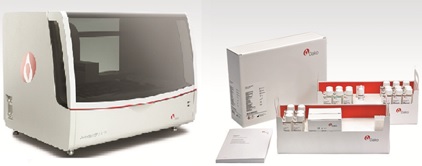EluNIR® Ridaforolimus Eluting Coronary Stent System - P170008
This is a brief overview of information related to FDA's approval to market this product. See the links below to the Summary of Safety and Effectiveness Data (SSED) and product labeling for more complete information on this product, its indications for use, and the basis for FDA's approval.
Product Name: EluNIR® Ridaforolimus Eluting Coronary Stent System
PMA Applicant: Medinol Ltd.
Address: Kiryat Atidim, Building 8, POB 58165, Tel Aviv 6158101, Israel
Approval Date: November 28, 2017
Approval Letter: https://www.accessdata.fda.gov/cdrh_docs/pdf17/P170008a.pdf
What is it? The EluNIR Ridaforolimus Eluting Coronary Stent System is a drug-coated metal tube (stent) used for the treatment of narrowing or blocakages to coronary arteries. The stent is coated with a polymer blend of Poly n-Butyl Methacrylate and the proprietary CarboSil mixed with the anti-proliferative drug, Ridaforolimus, to help supply blood to the heart and keep the coronary artery open. The device also includes catheter devliery system.
How does it work? The EluNIR delivery system is used with a traditional catheter with a small balloon placed on the end. The balloon catheter is inserted through the blood vessels in the groin or arm and advanced into a coronary artery, across the blockage or narrowing, and inflated to initially open the blockage or narrowing. As the balloon inflates, it stretches the coronary artery wall (a procedure known as balloon angioplasty). The balloon is then deflated, and the catheter is removed from the artery. The EluNIR delivery catheter is then positioned at the blockage of the coronary artery. The balloon on the EluNIR delivery system is inflated, which expands the stent and presses it against the coronary artery wall. This procedure may be followed by repeat balloon inflations within the stent to achieve the desired stent expansion. The stent remains permanently implanted within the coronary artery to help keep the artery open. The drug, Ridaforolimus, is released over time into the artery wall around the stent to help present the blood vessel from re-narrowing.
When is it used? The EluNIR Ridaforolimus Eluting Coronary Stent System is used in patients who have a narrowing in their coronary arteries caused by coronary artery disease - a condition that occurs when the arteries that supply oxygen-rich blood and nutrients to the heart become narrowed or blocked by a gradual build-up of “plaque.” Plaque is made of fatty deposits (cholesterol), white blood cells, calcium, and scar tissue that collect over time in the coronary arteries. If these arteries become narrowed or blocked, treatment may be required to improve blood flow and increase the supply of oxygen to the heart.
What will it accomplish? A significantly narrowed coronary artery limits blood and oxygen flow to the heart and can cause chest pain (angina) and damage to the heart muscle. Placement of the EluNIR stent within a narrowed coronary artery improves blood flow. The stent remains in the artery to help maintain the improved blood flow. After a coronary artery stent is implanted, re-narrowing of the artery may occur. The drug, Ridaforolimus, is released over time from the EluNIR stent surface into the artery wall to help prevent re-narrowing of the vessel.
The EluNIR Ridaforolimus Eluting Coronary Stent System was studied in the BIONICS clinical trial. A total of 1,919 patients participated in this clinical trial. The study measured outcomes at 12 months after the stent implantation procedure as well as long-term follow-up time points at 12, 24, 36, 48, and 60 months. The study met its goal (primary endpoint) at 12 months post-procedure follow-up by demonstrating that target lesion failure (a combined endpoint that includes cardiac death, repeat blockage in the treated artery, and repeat intervention in the previously treated blockage due to poor blood supply).
When should it not be used? The EluNIR Ridaforolimus Eluting Coronary Stent system should not be used in patients with the following:
- Patients who cannot receive recommended antiplatelet and/or anticoagulation therapy.
- Patients judged to have a lesion which prevents complete inflation of an angioplasty balloon or proper placement of the stent or delivery system.
- Patients with hypersensitivity or allergies to aspirin, heparin, clopidogrel, ticlopidine, drugs such as ridaforolimus or similar drugs, the polymer or its individual components CarboSil® 20 55D (Thermoplastic Silicone-Polycarbonate-urethane) and Poly n-Butyl Methacrylate (PBMA), cobalt, chromium, nickel, molybdenum, or contrast media.
Additional information (including warnings, precautions, and adverse events): Summary of Safety and Effectiveness Data and labeling are available online.
Other:

